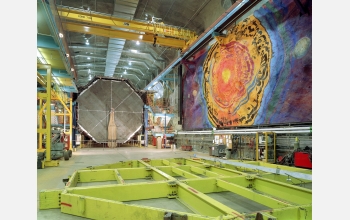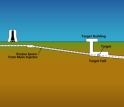News Release 05-031
The Neutrino Underground
Fermilab's NuMI/MINOS experiment will fire trillions of the ghostly particles through the Earth in an effort to learn their secrets

The cavern for the MINOS detector in Minnesota, with its commemorative mural
March 4, 2005
This material is available primarily for archival purposes. Telephone numbers or other contact information may be out of date; please see current contact information at media contacts.
An international consortium of 200-plus scientists, engineers, technical specialists and students has formally inaugurated an ambitious new effort to probe the secrets of neutrinos, the elusive subatomic particles that have played a central role in the origin of the universe, the evolution of the Sun, and much else.
Where do neutrinos come from? What are their masses? And how do they change from one kind to another? The researchers will attempt to answer such questions with the newly completed NuMI-MINOS experiment, which will send pulses of neutrinos on a 450-mile path through the Earth.
NuMI stands for Neutrinos at the Main Injector, the facility that produces the neutrino beam at the Fermi National Accelerator Laboratory in Batavia, Illinois, outside Chicago. MINOS refers to a pair of huge underground particle detectors that together comprise the Main Injector Neutrino Oscillation Search. One, the 1000-ton MINOS near detector at Fermilab, will monitor the neutrino beam as it heads outward. The other, the 6,000-ton MINOS far detector located a half-mile underground in the Soudan iron mine of northeastern Minnesota, will serve as the final target.
The detectors' job won’t be easy. Because neutrinos interact so rarely, trillions of them will pass through the MINOS near detector each year, but only about 1,500 per year will collide with atoms inside the detector and produce a signal. The rest will pass right through with no effect. It will be much the same story in Minnesota as in Illinois. Nonetheless, the detector there should be able to tell if some fraction of the neutrinos have changed from one kind to another during the 2.5-millisecond trip. MINOS scientists will then use the change from one type of neutrino to another as the key to discovering neutrinos’ secrets.
The Department of Energy provides the major share of funding for NuMI-MINOS project, with additional support coming from the National Science Foundation (NSF) and from the United Kingdom’s Particle Physics and Astronomy Research Council.
Michael Turner, NSF’s Assistant Director for Mathematics and the Physical Sciences, believes the neutrinos’ infinitesimal mass belies their significant and ubiquitous impact.
"Neutrinos are always referred to as ghostly particles, as if they are of little interest and have to be apologized for,” Turner says. “Nothing could be further from the truth. Neutrinos account for as much of the mass of the universe as do stars, they play a crucial role in the production of the chemical elements in the explosions of stars, and they may well explain the origin of the neutrons, protons and electrons that are the building blocks of all the atoms in the universe. MINOS will help us better understand how neutrinos shaped the universe we live in.”
-NSF-
-
A schematic drawing of NuMI, which generates the neutrino beam, and the MINOS near detector.
Credit and Larger Version
Media Contacts
Mike Perricone, Fermilab, 630-840-3351, email: mikep@fnal.gov
M. Mitchell Waldrop, NSF, (703) 292-8070, email: mwaldrop@nsf.gov
Program Contacts
Michael S. Turner, NSF, (703) 292-8800, email: mturner@nsf.gov
Related Websites
The NuMI/MINOS Project home page: http://www-numi.fnal.gov/
NuMI/MINOS Photos: http://www.fnal.gov/pub/presspass/press_releases/NuMI_photos
NuMI/MINOS Facts for Neighbors: http://www.fnal.gov/pub/about/public_affairs/neutrinos
The U.S. National Science Foundation propels the nation forward by advancing fundamental research in all fields of science and engineering. NSF supports research and people by providing facilities, instruments and funding to support their ingenuity and sustain the U.S. as a global leader in research and innovation. With a fiscal year 2023 budget of $9.5 billion, NSF funds reach all 50 states through grants to nearly 2,000 colleges, universities and institutions. Each year, NSF receives more than 40,000 competitive proposals and makes about 11,000 new awards. Those awards include support for cooperative research with industry, Arctic and Antarctic research and operations, and U.S. participation in international scientific efforts.
Connect with us online
NSF website: nsf.gov
NSF News: nsf.gov/news
For News Media: nsf.gov/news/newsroom
Statistics: nsf.gov/statistics/
Awards database: nsf.gov/awardsearch/
Follow us on social
Twitter: twitter.com/NSF
Facebook: facebook.com/US.NSF
Instagram: instagram.com/nsfgov



